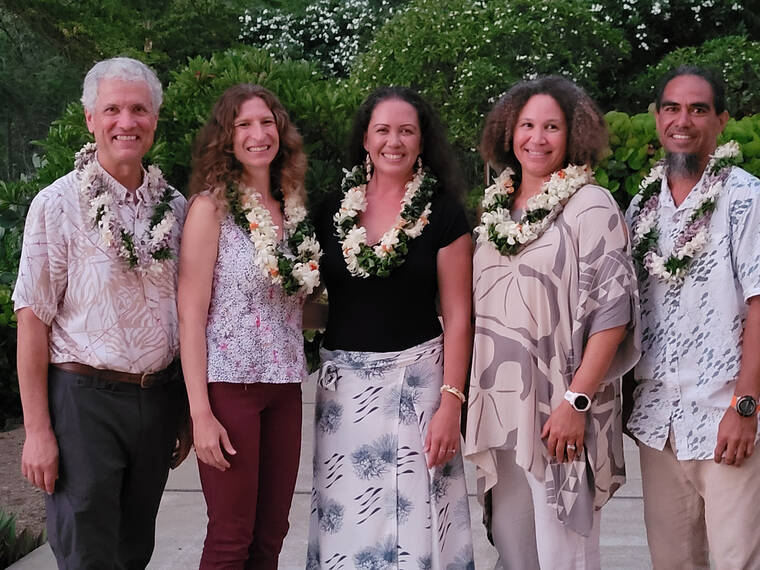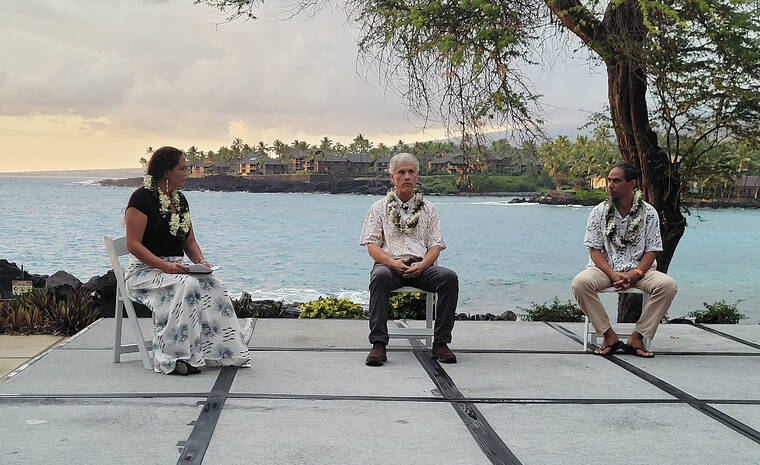Panel details Hawaii leadership on marine resources management
A recent panel discussion during the 45th annual U.S. Coral Reef Task Force meeting focused on the leadership Hawaii is showing the country and the world in the face of mounting challenges to conserve ocean resources.
Gov. David Ige announced the development of the Holomua: Marine 30X30 initiative six years ago. It calls for the effective management of at least 30% of nearshore waters by 2030, through the creation of marine managed areas. A recent example is the implementation of a Community-Based Subsistence Fishing Area surrounding Miloli‘i.
On Wednesday, a program manager from the DLNR Division of Aquatic Resources, representatives from the Hawaii Community Foundation and the Resources Legacy Fund, and state Rep. David Tarnas outlined not only the state’s leadership but also the critical importance of community involvement in moving forward.
“It’s not just us, it’s communities, it’s fishers. Holomua isn’t a one person or one agency thing. It’s a canoe,” said DAR program manager Luna Kekoa told meeting participants. “So, there are many people paddling in this canoe, and there are many people paddling that bring many different perspectives and expertise. You look around, we have community partners, the way they monitor is different from how DAR monitors. They look at resources in an area, they look at it from what is their ono or what they like to eat. DAR is partnering with them because they have that knowledge to fill the pukas in the State system. So, how do we bring all the pieces together? It’s not just science. It’s community science. It’s social science. It’s traditional science and bringing all that together is what Holomua tries to encompass.”
Dana Okano, a Hawaii Community Foundation program manager, added, “the State acknowledges that they cannot implement this (Hololmua) on their own and it must be co-management with community. For us, that was the beauty of this initiative. To really bring the community in and to make sure people have voice in the process and we want to support the community side during the process. We (HFC), can do that matchmaking by helping to bring funding to support the work that the community and the State are doing.”
So far, 14 foundations and philanthropic organizations have committed $8.8 million dollars to the goal of raising $3 million annually over the next 10 years to support Holomua.
“Hawaii is the model and a lot of funders are looking for ‘how does this work’ and ‘let’s see and let’s figure out how to replicate it in other places. They’re really looking for Hawaii to help provide those lessons learned to be a model for the rest of the country and the world hopefully,” Okano said.
In addition to the financial support the program is achieving, Jocelyn Herbert of Resources Legacy Fund, noted Hawaii’s international leadership in incorporating cultural values into management schemes.
“What we’re seeing here in Hawaii that is being so beautifully led here is this cultural guidance piece. This is a real innovation where Hawaii is leading, and I hope that other jurisdictions can take back some lessons from what you’re seeing here in that way,” Herbert said, encouraging other states, countries, and islands to follow.
Tarnas is the chairman of the House Land and Water Committee and echoed the theme of community involvement.
“So, the power comes from the people, that’s an old saying and it’s very true. I’m a firm believer that the legislative process is a team process and it’s involving the community, advocacy organizations, private businesses, non-governmental organizations, all of them bringing their mana’o to the table,” he said.
Tarnas said the first funding the legislature appropriated for the Holomua: Marine 30X30 initiative was specifically for community engagement.
“The legislature really believed, and I think we showed through that appropriation, our priority was to make sure that the community is aware and involved. It’s essential that we include those who utilize the resources.”
Though Ige’s term ends in December, the Holomua initiative will continue.
DAR has adopted the Holomua as our nearshore management plan. This is how we see DAR, communities, and fishers moving forward. Whether or not next governor is going to be in the canoe, DAR is on board. This is our initiative, our kuleana, and we need all our partners to make it happen. Through changes in administration, DAR is in our wa’a and we’re paddling,” Kekoa said.



